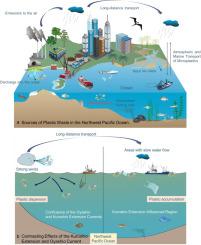Not Just a Corridor: Hydrodynamic Traps and Fiber Risk in the Kuroshio Extension
IF 12.4
1区 环境科学与生态学
Q1 ENGINEERING, ENVIRONMENTAL
引用次数: 0
Abstract
Microplastics (MPs) are widespread in marine systems, yet their dynamics and risks remain poorly understood in open-ocean regions. This study presents the first high-resolution assessment of MPs in surface waters of the Kuroshio Extension (KE), a dynamic current system in the Northwest Pacific. Across 26 sites (35°–45°N, 148°–162°E), MP concentrations ranged from 0.32 to 23.68 items/m³ (mean 3.04 ± 5.54 items/m³), with fiber Polyethylene Terephthalate (PET) dominating (>79%). We identified two key mechanisms shaping pollution patterns: mesoscale eddies enhance local accumulation, while strong current systems drive long-range transport. Fisheries and shipping emerged as major MP sources based on polymer type, morphology, and color signatures. A partial least squares (PLS) regression model showed that surface salinity and dissolved oxygen promote MP retention, while deeper chlorophyll maxima and warmer Sea Surface Temperature (SST) reduce it. These dynamics were captured by a newly developed Eco-Hydrological Co-regulation Index (ECI), which strongly correlated with MP abundance (r = 0.84, p < 0.05). Ecological risks were evaluated using the Pollution Load Index (PLI), Polymer Hazard Index (PHI), and Ecological Risk Index (ERI), supported by Monte Carlo simulations. While most sites posed low to moderate risk, two sites exceeded regional thresholds due to high-toxicity polymers. Overall, the KE acts as both a transboundary conduit and a sorting hub for MPs, emphasizing the need for microfiber-specific regulation and multidimensional risk assessment frameworks in offshore environments.

不只是一条走廊:黑潮延伸区的水动力陷阱和纤维风险
微塑料(MPs)在海洋系统中广泛存在,但在公海地区,人们对其动态和风险知之甚少。本研究首次对西北太平洋黑潮延伸区(KE)地表水的MPs进行了高分辨率评估。在26个站点(北纬35°-45°,东经148°-162°)中,MP浓度范围为0.32至23.68个/m³(平均3.04±5.54个/m³),聚酯纤维占主导地位(>79%)。我们确定了形成污染模式的两个关键机制:中尺度涡旋增强了局部积累,而强洋流系统推动了远距离输送。基于聚合物类型、形态和颜色特征,渔业和航运成为主要的MP来源。偏最小二乘(PLS)回归模型表明,表层盐度和溶解氧促进了MP的保留,而较高的叶绿素最大值和较高的海温(SST)则降低了MP的保留。这些动态被新开发的生态水文共同调节指数(ECI)捕获,该指数与MP丰度密切相关(r = 0.84,p < 0.05)。采用污染负荷指数(PLI)、聚合物危害指数(PHI)和生态风险指数(ERI)对生态风险进行评估,并采用蒙特卡罗模拟支持。虽然大多数地点构成低至中等风险,但由于高毒性聚合物,两个地点超过了区域阈值。总的来说,KE既是一个跨界管道,也是一个MPs的分类中心,强调了在海上环境中对微纤维特定监管和多维风险评估框架的需求。
本文章由计算机程序翻译,如有差异,请以英文原文为准。
求助全文
约1分钟内获得全文
求助全文
来源期刊

Water Research
环境科学-工程:环境
CiteScore
20.80
自引率
9.40%
发文量
1307
审稿时长
38 days
期刊介绍:
Water Research, along with its open access companion journal Water Research X, serves as a platform for publishing original research papers covering various aspects of the science and technology related to the anthropogenic water cycle, water quality, and its management worldwide. The audience targeted by the journal comprises biologists, chemical engineers, chemists, civil engineers, environmental engineers, limnologists, and microbiologists. The scope of the journal include:
•Treatment processes for water and wastewaters (municipal, agricultural, industrial, and on-site treatment), including resource recovery and residuals management;
•Urban hydrology including sewer systems, stormwater management, and green infrastructure;
•Drinking water treatment and distribution;
•Potable and non-potable water reuse;
•Sanitation, public health, and risk assessment;
•Anaerobic digestion, solid and hazardous waste management, including source characterization and the effects and control of leachates and gaseous emissions;
•Contaminants (chemical, microbial, anthropogenic particles such as nanoparticles or microplastics) and related water quality sensing, monitoring, fate, and assessment;
•Anthropogenic impacts on inland, tidal, coastal and urban waters, focusing on surface and ground waters, and point and non-point sources of pollution;
•Environmental restoration, linked to surface water, groundwater and groundwater remediation;
•Analysis of the interfaces between sediments and water, and between water and atmosphere, focusing specifically on anthropogenic impacts;
•Mathematical modelling, systems analysis, machine learning, and beneficial use of big data related to the anthropogenic water cycle;
•Socio-economic, policy, and regulations studies.
 求助内容:
求助内容: 应助结果提醒方式:
应助结果提醒方式:


